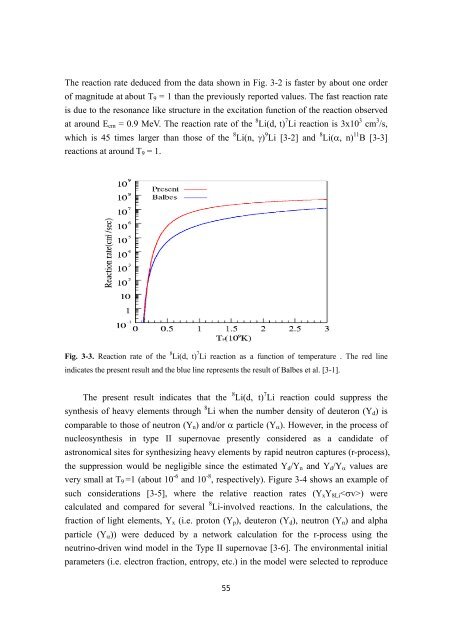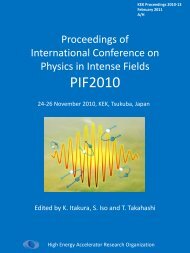TRIAC Progress Report - KEK
TRIAC Progress Report - KEK
TRIAC Progress Report - KEK
Create successful ePaper yourself
Turn your PDF publications into a flip-book with our unique Google optimized e-Paper software.
The reaction rate deduced from the data shown in Fig. 3-2 is faster by about one order<br />
of magnitude at about T9 = 1 than the previously reported values. The fast reaction rate<br />
is due to the resonance like structure in the excitation function of the reaction observed<br />
at around Ecm = 0.9 MeV. The reaction rate of the 8 Li(d, t) 7 Li reaction is 3x10 3 cm 3 /s,<br />
which is 45 times larger than those of the 8 Li(n, γ) 9 Li [3-2] and 8 Li(α, n) 11 B [3-3]<br />
reactions at around T9 = 1.<br />
Fig. 3-3. Reaction rate of the 8 Li(d, t) 7 Li reaction as a function of temperature . The red line<br />
indicates the present result and the blue line represents the result of Balbes et al. [3-1].<br />
The present result indicates that the 8 Li(d, t) 7 Li reaction could suppress the<br />
synthesis of heavy elements through 8 Li when the number density of deuteron (Yd) is<br />
comparable to those of neutron (Yn) and/or α particle (Yα). However, in the process of<br />
nucleosynthesis in type II supernovae presently considered as a candidate of<br />
astronomical sites for synthesizing heavy elements by rapid neutron captures (r-process),<br />
the suppression would be negligible since the estimated Yd/Yn and Yd/Yα values are<br />
very small at T9 =1 (about 10 -6 and 10 -8 , respectively). Figure 3-4 shows an example of<br />
such considerations [3-5], where the relative reaction rates (YxY8Li) were<br />
calculated and compared for several 8 Li-involved reactions. In the calculations, the<br />
fraction of light elements, Yx (i.e. proton (Yp), deuteron (Yd), neutron (Yn) and alpha<br />
particle (Yα)) were deduced by a network calculation for the r-process using the<br />
neutrino-driven wind model in the Type II supernovae [3-6]. The environmental initial<br />
parameters (i.e. electron fraction, entropy, etc.) in the model were selected to reproduce<br />
55













